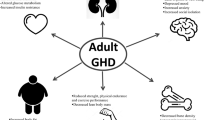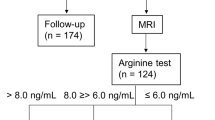Abstract
The diagnosis of GH deficiency (GHD) is based on the measurement of peak GH responses to pharmacological stimuli. Pharmacological stimuli, however, lack precision, accuracy, are not reproducible, are invasive, non-physiological and some may even be hazardous. Furthermore, different GH commercial assays used to measure GH in serum yield results that may differ considerably. In contrast to GH, IGF-I can be measured on a single, randomly-obtained blood sample. A review of the available data indicates that IGF-I measurement in the diagnosis of childhood-onset isolated GHD has a specificity of up to 100%, with a sensitivity ranging from about 70 to 90%. We suggest an algorithm in which circulating levels of IGF-I together with the evaluation of auxological data, such as growth rate and growth, may be used to assess the likelihood of GHD in pre-pubertal children.
Similar content being viewed by others
References
Sizonenko PC, Clayton PE, Cohen P, Hintz RL, Tanaka T, Laron Z. Diagnosis and management of growth hormone deficiency in childhood and adolescence. Part I: diagnosis of growth hormone deficiency. Growth Horm IGF Res 2001, 11: 137–65.
Rosenfeld RG, Albertsson-Wikland K, Cassorla F. Diagnostic controversy: the diagnosis of childhood growth hormone deficiency revisited. J Clin Endocrinol Metab 1995, 80: 1532–40.
Shalet SM, Toogood A, Rahim A, Brennan BM. The diagnosis of growth hormone deficiency in children and adults. Endocr Rev 1998, 19: 203–23.
Consensus guidelines for the diagnosis and treatment of growth hormone (GH) deficiency in childhood and adolescence: Summary statement of the GH Research Society. GH Research Society. J Clin Endocrinol Metab 2000, 85: 3990–3.
Saggese G, Ranke MB, Saenger P. Diagnosis and treatment of growth hormone deficiency in children and adolescents: Towards a consensus. Ten years after the availability of recombinant human growth hormone. Horm Res 1998, 50: 320–40.
Gandrud L, Wilson DM. Is growth hormone stimulation testing in children still appropriate? Growth Horm IGF Res 2004, 14: 185–94.
Loche S, Bizzarri C, Maghnie M, et al. Results of early reevaluation of growth hormone secretion in short children with apparent growth hormone deficiency. J Pediatr 2002, 140: 445–9.
Ghigo E, Bellone J, Aimaretti G, et al. Reliability of provocative tests to assess GH secretory status: study in 472 normally growing children. J Clin Endocrinol Metab 1996, 81: 3323–7.
Bercu BB, Shulman D, Root AW, Spiliotis BE. Growth hormone (GH) provocative testing frequently does not reflect endogenous GH secretion. J Clin Endocrinol Metab 1986, 63: 706–16
Seminara S, Filpo A, Piccinini P, et al. Growth hormone (GH) response to GH-releasing hormone in short children: lack of correlation with endogenous nocturnal GH secretion. J Endocrinol Invest 1997, 20: 118–21.
Rose SR, Ross JL, Uriarte M, Barnes KM, Cassorla FG, Cutler GB Jr. The advantage of measuring stimulated as compared with spontaneous growth hormone levels in the diagnosis of growth hormone deficiency. N Engl J Med 1988, 319: 201–7.
Chaler E, Belgorosky A, Maceiras M, Mendioroz M, Rivarola MA. Between-assay differences in serum growth hormone (GH) measurements: importance in the diagnosis of GH deficiency in childhood. Clin Chem 2001, 47: 1735–8.
Celniker AC, Chen AB, Wert RM Jr, Sherman BM. Variability in the quantitation of circulating growth hormone using commercial immunoassays. J Clin Endocrinol Metab 1989, 68: 469–76.
Mauras N, Walton P, Nicar M, Welch S, Rogol AD. Growth hormone stimulation testing in both short and normal statured children: Use of an immunofunctional assay. Pediatr Res 2000, 48: 614–8.
Cianfarani S, Boemi S, Spagnoli A, et al. Is IGF binding protein-3 assessment helpful for the diagnosis of GH deficiency? Clin Endocrinol (Oxf) 1995: 43–7.
Nunez SB, Municchi G, Barnes KM, Rose SR. Insulin-like growth factor (IGF)-I and IGF-binding protein-3 concentrations compared to stimulated and night growth hormone in the evaluation of short children: A clinical research centre study. J Clin Endocrinol Metab 1996, 81: 1927–32.
Juul A, Skakkebaek NE. Prediction of the outcome of growth hormone provocative testing in short children by measurement of serum levels of insulin-like growth factor-I and insulin-like growth factor binding protein-3. J Pediatr 1997, 130: 197–204.
Tillman V, Buckler JMH, Kibirige MS, Price DA, Shalet SM, Wales JKH. Biochemical tests in the diagnosis of childhood growth hormone deficiency. J Clin Endocrinol Metab 1997, 82: 531–5.
Rikken B, van Doorn J, Ringeling A, van den Brande JL, Massa G, Wit JM. Plasma levels of insulin-like growth factor (IGF)-I, IGF-II and IGF-binding protein-3 in the evaluation of childhood growth hormone deficiency. Horm Res 1998, 50: 166–76.
Mitchell H, Dattani MT, Nanduri V, Hindmarsh PC, Preece MA, Brook CGD. Failure of IGF-I and IGFBP-3 to diagnose growth hormone insufficiency. Arch Dis Child 1999, 80: 443–7.
Weinzimer SA, Homan SA, Ferry RJ, Moshang T. Serum IGF-I and IGFBP-3 concentrations do not accurately predict growth hormone deficiency in children with brain tumours. Clin Endocrinol (Oxf) 1999, 51: 339–45.
Granada ML, Murillo J, Lucas A, et al. Diagnostic efficiency of serum IGF-I, IGF-binding protein-3 (IGFBP-3), IGF-I/ IGFBP-3 molar ratio and urinary GH measurements in the diagnosis of adult GH deficiency: Importance of an appropriate reference population. Eur J Endocrinol 2000, 142: 243–53.
Bussieres L, Souberbielle JC, Pinto G, Adan L, Noel M, Brauner R. The use of insulin-like growth factor 1 reference values for the diagnosis of growth hormone deficiency in prepubertal children. Clin Endocrinol (Oxf) 2000, 52: 735–9.
Ranke MB, Schweizer R, Elmlinger MW, et al. Significance of basal IGF-I, IGFBP-3 and IGFBP-2 measurements in the diagnostics of short stature in children. Horm Res 2000, 50: 60–8.
Cianfarani S, Tondinelli T, Spadoni GL, Scirè G, Boemi S, Boscherini B. Height velocity and IGF-I assessment in the diagnosis of childhood onset GH insufficiency: do we still need a second GH stimulation test? Clin Endocrinol (Oxf) 2002, 57: 161–7.
Lissett CA, Jonsson P, Monson JP, Shalet SM. Determinants of IGF-I status in a large cohort of growth hormone-deficient subjects. The role of timing of onset of growth hormone deficiency. Clin Endocrinol (Oxf) 2003, 59: 773–8.
Das U, Whatmore AJ, Khosravi J, Wales JKH, Butler G. IGF-I and IGF-binding protein-3 measurements on filter paper blood spots in children and adolescents on GH treatment. Use in monitoring and as marker of growth performance. Eur J Endocrinol 2003, 149: 179–85.
Boquete HR, Sobrado PG, Fideleff HL, et al. Evaluation of diagnostic accuracy of insulin-like growth factor (IGF)-I and IGF-binding protein-3 in growth hormone-deficient children and adults using ROC plot analysis. J Clin Endocrinol Metab 2003, 88: 4702–8.
Jensen RB, Jeppesen KA, Vielwerth S, et al. Insulin-like growth factor-I (IGF-I) and IGF-binding protein-3 as diagnostic markers of growth hormone deficiency in infancy. Horm Res 2005, 63: 15–21.
Cianfarani S, Liguori A, Boemi S, et al. Inaccuracy of IGFBP-3 assessment in the diagnosis of growth hormone deficiency (GHD) from childhood to young adulthood: Association to low GH-dependency of IGF-II and presence of circulating IGFBP-3 18 kD fragment. J Clin Endocrinol Metab 2005, 90: 6028–34.
Blum WF, Ranke MB, Kietzmann K, Gauggel E, Zeisel HJ, Bierich JR. A specific radioimmunoassay for the growth hormone (GH)-dependent somatomedin-binding protein: its use for diagnosis of GH deficiency. J Clin Endocrinol Metab 1990, 70: 1292–8.
Hasegawa Y, Hasegawa T, Aso T, Kotoh S, Nose O, Ohyama Y. Clinical utility of insulin-like growth factor binding protein-3 in the evaluation and treatment of short children with suspected growth hormone deficiency. EurJ Endocrinol 1994, 131: 27–32.
Rosenfeld RG, Wilson DM, Lee PDK, Hintz RL. Insulin-like growth factors I and II in evaluation of growth retardation. J Pediatr 1986, 109: 428–33.
Baxter RC. Circulating binding proteins for the insulin-like growth factors. Tr Endocrinol Metab 1993, 4: 91–6.
Zapf J, Walter H, Froesch ER. Radioimmunological determination of insulin like growth factor I and II in normal subjects and in patients with growth disorders and extra pancreatic tumor hypoglycaemia. J Clin Invest 1981, 68: 1321–30.
BarrecaA, Bozzola M, Cesarone A, et al. Short stature associated with high circulating insulin-like growth factor (IGF)-binding protein-1 and low circulating IGF-II: effect of growth hormone therapy. J Clin Endocrinol Metab 1998, 83: 3534–41.
Juul A, Moller S., Mosfeldt-Laursen E, et al. The acid-labile subunit of human ternary insulin-like growth factor binding protein complex in serum: hepatosplanchnic release, diurnal variation, circulating concentrations in healthy subjects, and diagnostic use in patients with growth hormone deficiency. J Clin Endocrinol Metab 1998, 83: 4408–15.
Domene HM, Bengolea SV, Martinez AS, et al. Deficiency of the circulating insulin-like growth factor system associated with inactivation of the acid-labile subunit gene. N Engl J Med 2004, 350: 570–7.
Maghnie M, Strigazzi C, Tinelli C, et al. Growth hormone (GH) deficiency (GHD) of childhood onset: reassessment of GH status and evaluation of the predictive criteria for permanent GHD in young adults. J Clin Endocrinol Metab 1999, 84: 1324–8.
Maghnie M, Ghirardello S, Genovese E. Magnetic resonance imaging of the hypothalamus-pituitary unit in children suspected of hypopituitarism: Who, how and when to investigate. J Endocrinol Invest 2004, 27: 496–509.
Author information
Authors and Affiliations
Consortia
Corresponding author
Additional information
See appendix.
Rights and permissions
About this article
Cite this article
Federico, G., Street, M.E., Maghnie, M. et al. Assessment of serum IGF-I concentrations in the diagnosis of isolated childhood-onset GH deficiency: A proposal of the Italian Society for Pediatric Endocrinology and Diabetes (SIEDP/ISPED). J Endocrinol Invest 29, 732–737 (2006). https://doi.org/10.1007/BF03344184
Accepted:
Published:
Issue Date:
DOI: https://doi.org/10.1007/BF03344184




